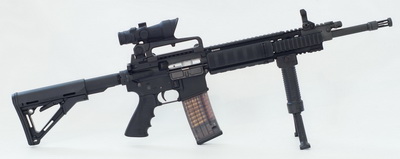The last time I wrote about the AR-15 rifle platform my biggest design complaint was the Direct Gas Impingement (DGI) action. This has been a feature since the very first generation of the weapon adopted by the military over 45 years ago. DGI contributes to the platform’s simplicity and lightness, but also has some undesirable consequences: Every time the gun fires it blasts hot propellant gasses back into the bolt carrier, baking a layer of carbon onto everything in the receiver. Decades of military service have proven that well-made AR-15’s can withstand this abuse and continue to function reliably with just basic cleaning and lubrication. But for obsessive owners who like to keep their guns in more immaculate condition this dirty design can be quite irritating.
When I bought my first AR-15 following the 2004 expiration of the federal “Assault Weapons” Ban I openly wondered why no manufacturer had produced a piston-driven variant of the gun, especially given the huge market for America’s favorite tactical rifle. Since then I tracked the gradual emergence of AR-15 piston actions, first as retrofit kits, then as new uppers and complete guns. There was a great deal of concern about the long-term reliability of converted actions, mostly because the AR-15 bolt carrier wasn’t designed to be hammered with a piston, and its geometry seemed prone to an adverse effect called “bolt carrier tilt.” Some manufacturers, most notably LWRC, built a new action from scratch to mitigate these concerns. However LWRC’s piston uppers were always very hard to acquire, and even today they command huge premiums.
In mid 2009 Ruger entered the AR-15 market for the first time, and they did so with a proprietary piston action. The SR-556 now represents the best value in piston-driven AR-15s. I sold my old DGI AR-15 to somebody less fastidious than me and last month managed to pick up a new SR-556 for just under $1500.
The SR-556 comes standard with a number of desirable upgrades over basic AR-15s. Among them:
- Full-length quad-rail handguards, so you can easily add as many accessories as you can carry.
- Top-quality folding iron sights (by Troy Industries).
- A comfortable pistol grip (by Hogue).
- Chrome-plated bolt carrier assembly, so what little dirt does get into the action can easily be wiped off.
The piston system was executed superbly. Only the three pieces in the front two inches need to be removed for cleaning. The piston regulator has four positions. In the off position the action doesn’t cycle, essentially giving you a bolt-action gun. The first position (smallest gas opening) is suited to use with silencers, which sustain more backpressure on the action. The second position cycles the action reliably under normal conditions, and the largest opening can be used to compensate for weak ammunition, a very dirty gun, or other harsh conditions.
Shooting the gun for the first time was a pleasure. There were absolutely no malfuctions. Even after sustained firing the bolt was cool to the touch (though the barrel and gas vent area still got quite hot!). Long-term reliability on a new design may not be certain, but the fact that Ruger is comfortable enough to roll these out in quantity is reassuring. This should certainly outlast piston systems that use DGI bolt carriers with their separate gas key: The SR-556 carrier is machined from a single piece of steel with just a little hump over the main tube to take the impact of the piston.
Out of the box this is a very good gun, but it does have a few shortcomings:
- Like all piston guns this is both front-heavy and heavier (just under 8 pounds) than comparable DGI AR-15s (typically closer to 7 pounds). Of course even professional users of the DGI M4s have found it beneficial to put a vertical grip on the front of their guns. I added a GripPod ($80 from Botach) and found this mitigates the imbalance nicely, in addition to deploying a handy bipod when desired.
- The flash suppressor has uniform slots around its entire diameter. When shooting prone or on a table this causes some of the muzzle blast to kick up dust. Although closed-bottom flash suppressors require indexing to install, this should be a trivial factor to accommodate on a production line. So shame on Ruger for not equipping this with a closed-bottom flash suppressor!
- The telescoping buttstock is a standard M4 style, which leaves a lot of play between the stock and the buffer tube. They should have just equipped it from the start with a Magpul CTR (shown in the photo above), for which I had to pay another $80. (To fit this gun be sure to get the mil-spec, not commercial size CTR!)
- It doesn’t come with a front sling loop or swivel.


